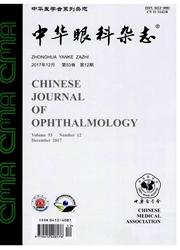

 中文摘要:
中文摘要:
目的:对比霉酚酸酯等不同的免疫抑制药物对甲状腺相关性眼病的疗效和安全性,旨在寻求甲状腺相关眼病治疗的有效手段。方法共115例甲状腺相关性眼病患者被纳入本研究,所有患者被随机分成A、B、C三组,A组患者采用糖皮质激素泼尼松(30例),B组患者采用雷公藤多甙(TⅡ,45例)治疗,C 组患者采用霉酚酸酯(MMF,40例)治疗,疗程12周。疾病的严重程度和疗效判断采用改良Given-Wilson 积分指数系统,设定积分下降或上升≥3分为好转或恶化,<3分为无变化。合并甲状腺功能亢进或甲状腺功能减退者同时服用抗甲状腺药物或左旋甲状腺素片以调节甲状腺功能。结果12周末,糖皮质激素组30例中15例(50%)好转,15例(50%)无变化;TⅡ组29例(64.4%)好转,16例(35.6%)无变化;MMF组36例(90.0%)好转,4例(10.0%)无变化。TⅡ组和糖皮质激素组相比,好转率之间无显著差异(P>0.05),而MMF组的好转率高于TⅡ组和糖皮质激素组(P<0.05)。所有115例患者均未出现眼部症状的恶化。各组治疗后的积分值均有一定程度下降(P<0.01),下降幅度从大到小依次为MMF组、TⅡ组、糖皮质激素组。霉酚酸酯组3例(7.5%)出现轻度转氨酶异常;TⅡ组4例(8.9%)出现轻度月经异常,1例(2.2%)出现皮疹;糖皮质激素组2例(6.7%)出现轻度月经异常,1例(3.3%)出现体重增加,2例(6.7%)出现胃部不适,1例(3.3%)出现轻度转氨酶异常。结论新型免疫抑制药MMF用于治疗甲状腺相关性眼病疗效似乎优于TⅡ及糖皮质激素,且副作用较少;小剂量TⅡ治疗甲状腺相关性眼病的疗效与糖皮质激素相仿,但患者的耐受性较好且副作用更少。
 英文摘要:
英文摘要:
Objective By analyzing the efficacy and safety of mycophenolate mofetil and other immunosuppressants for Graves' ophthalmopathy (GO), we aim to seek for effective treatment for Graves' ophthalmopathy. Methods 115 untreated GO patients were enrolled in this study. All these Patients were divided into group A, group B and group C. The patients in group A were given prednisone (n=30), the patients in group B were given tripterygium multi glycosides (TⅡ, n=45), and those in group C were given mycophenolate mofetil (MMF, n=40). The course of treatment is 12 weeks. The disease severity and therapeutic response were quantitatively assessed according to the Ophthalmopathy Index Scoring System from Given-wilson (1989) with sensibly modified. The improvement or progression of ophthalmopathy was defined if the variation, either increase or decrease of the score, reached 3 or more in the ophthalmopathy index. If this did not occur, a lack of response was indicated. In patients who had hyperthyroidism or hypothyroidism, antithyroid drugs or levothyroxine were also administered to regulate thyroid function. Results After 12-week therapy, 15(50%) of the 30 treated with glucocorticoid improved and the remaining 15(50%) unchanged. In TⅡ group, 29(64.4%) of the 45 responded to the therapy and the remaining 16(35.6%) had no change. There was no significant difference in clinical response between the 2 groups (P〉0.05). In mycophenolate mofetil group, 36(90.0%) of the 40 improved and the remaining 4 (10.0%) had no change. It seems that MMF is more effective than TⅡ and glucocorticoid in the treatment of GO. There was significant difference in clinical response between the mycophenolate mofetil group and the other two 2 groups (P〈0.05). None of the 115 patients had worsening of ophthalmopathy. The scores in each group all decreased to some extent after treatment(P〈0.01). The falling range from large to small are mycophenolate mofetil, TⅡ and g
 同期刊论文项目
同期刊论文项目
 同项目期刊论文
同项目期刊论文
 期刊信息
期刊信息
